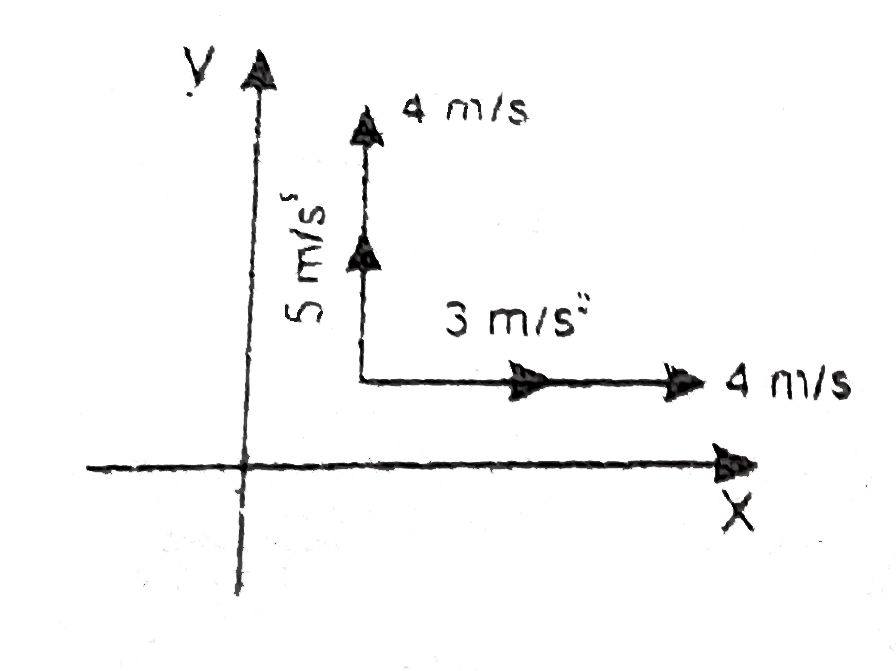A projectile is given an initial velocity of (ˆi+2ˆj)m/s, where ˆi is along the ground and ˆj is along the vertical . If g=10m/s2, the equation of its trajectory is :
y=2x−5x2
y=x−5x2
4y=2x−5x2
y=2x−25x2
The correct Answer is:A
To find the equation of the trajectory of a projectile given its initial velocity, we can follow these steps:
Step 1: Identify the initial velocity components
The initial velocity of the projectile is given as u=^i+2^j m/s. We can identify the horizontal and vertical components of the initial velocity:
- ux=1 m/s (horizontal component)
- uy=2 m/s (vertical component)
Step 2: Write the equations of motion
The equations of motion for a projectile can be expressed as:
- Horizontal motion: x=uxt
- Vertical motion: y=uyt−12gt2
Where g=10 m/s² is the acceleration due to gravity.
Step 3: Solve for time t
From the horizontal motion equation, we can express time t in terms of x:
t=xux=x1=x seconds
Step 4: Substitute t into the vertical motion equation
Now, substitute t=x into the vertical motion equation:
y=uyt−12gt2
Substituting the values:
y=2x−12⋅10⋅x2
y=2x−5x2
Step 5: Write the final equation of the trajectory
Thus, the equation of the trajectory of the projectile is:
y=2x−5x2
Summary of the solution
The equation of the trajectory for the given projectile is y=2x−5x2.
---
The initial velocity of the projectile is given as u=^i+2^j m/s. We can identify the horizontal and vertical components of the initial velocity:
- ux=1 m/s (horizontal component)
- uy=2 m/s (vertical component)
The equations of motion for a projectile can be expressed as:
- Horizontal motion: x=uxt
- Vertical motion: y=uyt−12gt2
From the horizontal motion equation, we can express time t in terms of x:
t=xux=x1=x seconds
Now, substitute t=x into the vertical motion equation:
y=uyt−12gt2
Substituting the values:
y=2x−12⋅10⋅x2
y=2x−5x2
Thus, the equation of the trajectory of the projectile is:
y=2x−5x2
The equation of the trajectory for the given projectile is y=2x−5x2.
Topper's Solved these Questions
- KINEMATICS-2BOOK - CENGAGE PHYSICS ENGLISHCHAPTER - KINEMATICS-2EXERCISE - Exercise Multiple Correct
11 Videos
- KINEMATICS-2BOOK - CENGAGE PHYSICS ENGLISHCHAPTER - KINEMATICS-2EXERCISE - Exercise Assertion - Reasoning
5 Videos
- KINEMATICS-2BOOK - CENGAGE PHYSICS ENGLISHCHAPTER - KINEMATICS-2EXERCISE - Exercise Subjective
40 Videos
- KINEMATICS-1BOOK - CENGAGE PHYSICS ENGLISHCHAPTER - KINEMATICS-1EXERCISE - Integer
9 Videos
- KINETIC THEORY OF GASESBOOK - CENGAGE PHYSICS ENGLISHCHAPTER - KINETIC THEORY OF GASESEXERCISE - Compression
2 Videos
Similar Questions
A projectile is given an initial velocity of (ˆi+2ˆj) The Cartesian equation of its path is (g=10ms−1) ( Here , ˆi is the unit vector along horizontal and ˆj is unit vector vertically upwards)
View SolutionA particle has an initial velocity of 3ˆi+4ˆj and an acceleration of 0.4ˆi+0.3ˆj. Its speed after 10s is :
View Solution
Knowledge Check
Unit vector along the vector ˆi+ˆj+ˆk is
A13(ˆi+ˆk+ˆk)B12(ˆi+ˆj+ˆk)C1√3(ˆi+ˆj+ˆk)D1√2(ˆi+ˆj+ˆk)
A particle has an initial velocity of 3ˆi+4ˆj and an acceleration of 0.4ˆi+0.3ˆj. Its speed after 10s is :
View SolutionA projectile is projected in air with initial velocity →v=(3ˆi+4ˆj) m/s from the origin. The equation of trajectory of the projectile is given as (g=−10ˆjms2) (neglect air resistance )
View SolutionA particle has initial velocity of (3ˆi+4ˆj)m/s and a acceleration of (4ˆi−3ˆj)m/s2. Its speed after one second will be equal to :-
View SolutionThe unit vector along →A=2ˆi+3ˆj is :
View SolutionThe component of vector A=2ˆi+3ˆj along the vector ˆi+ˆj is
View SolutionA particle has initial velocity (3ˆi+4ˆj) and has acceleration (0.4ˆi+0.3ˆj). Its speed after 10s is.
View SolutionA particle is moving in x-y plane. At an instant, it has velocity (4ˆi+4ˆj)m/s and acceleration (3ˆi+5ˆj)m/s2 At that instant, the radius of curvature of its path will be :

View Solution
